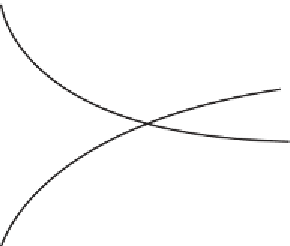Geoscience Reference
In-Depth Information
Figure 15.1. Factors of soil formation.
semi-arid central Sudan (Ruxton,
1958
). Milne (
1935
;
1936
;
1947
), Ruxton (
1958
)
and Webster (
1965
) identified and mapped soils forming genetically linked topo-
graphic patterns, or
toposequences
, in semi-arid East Africa, Sudan and Zambia.
Such toposequences are also known as soil
catenas
, from the Latin word for chain
(Milne,
1935
). It is worth remembering that a number of different soil types can occur
within one catena, ranging from weakly developed regosols to highly organic his-
tosols (see
Table 15.1
). Subsequent erosion may only leave remnants of one soil type,
so great caution is needed before invoking a particular regional climate, especially if
much of the former topography has been destroyed.
As time progresses, the influence of the more active factors (climate; biological
activity) will tend to outweigh that of the passive factors (
Figure 15.1
). In deserts,
where water is a limiting factor, biological activity is curtailed and only becomes
important during those intervals of time when precipitation increases, that is, during
wetter climatic phases. If the humid climatic phases are brief, little soil development
will occur other than some minor organic staining and weak soil horizon development
of the parent material, whether it be weathered bedrock or sediment. Strictly speaking,
climate should refer to
soil climate
, and will reflect the interaction of soil water and
temperature, modulated by soil permeability and infiltration capacity.
The influences of soil climate and local topography are mediated through the biota,
including soil microorganisms, insects (especially termites, ants and worms), larger
burrowing mammals and birds. The interaction of each of the agents of soil formation
produces what are known as soil horizons, in which a horizon is a gently sloping or
horizontal layer of soil with certain diagnostic traits, such as colour, structure (the
arrangement of soil aggregates, or peds), texture (clay, silt and sand content as assessed
in the field by manipulating moistened soil) and other features, such as calcium
























